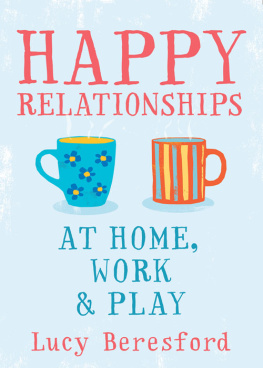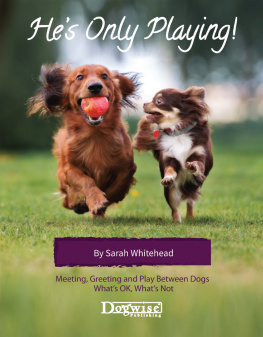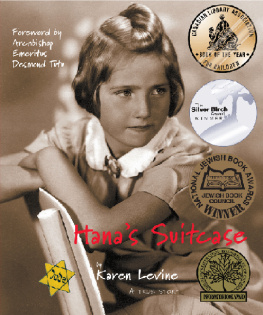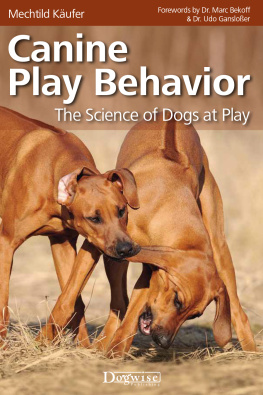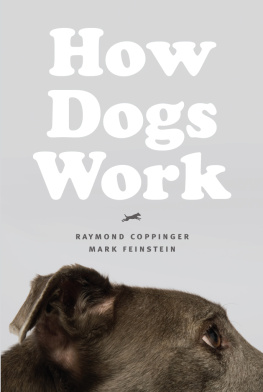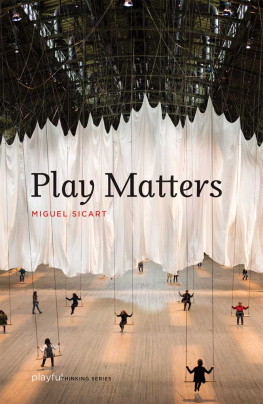Karen B. London
Patricia B. McConnell


"It's fun to have fun but you have to know how."
-The Cat in the Hat, by Dr. Seuss
.................................. 3
....................... 7
Play is powerful stuff. It influences so many things, including development, motivation, emotions, physiology, communication, and behavior. Wow! That's an impressive list. That's why we believe that play between people and dogs deserves a booklet of its own.
The thoughtful use of play can do much to improve the lives of both people and dogs. Most importantly, play is an effective (and delightful!) way to strengthen our relationships with dogs. Given that people and dogs are members of two different species, what could be more important? We are all used to the idea of being best friends with our dogs, but that relationship shouldn't be taken for granted. Sometimes we forget how special it is. People are amazed to read about individuals of other species who live and play together-a gorilla with a pet kitten, or a dog who raises squirrels, for example-but the fact that we live with dogs isn't considered newsworthy. However, there's no denying that our relationship with dogs is a bit of a miracle, given how closely connected our lives have become.
One of those juvenile traits is playfulness, and dogs and people have it in spades-you and your dog are basically modern day Peter Pans. Thus, play is part of our biological bond, and for many of us, part of our day-to-day link with dogs.
At its simplest, play is fun, and there's nothing like having fun with someone to make you want to spend more time together.
Perhaps this is a good time to ask "what is play, anyway?" Webster's dictionary defines play as "to occupy oneself in amusement, sport or other recreation: (i.e.) children playing with toys." That is a broad definition, encompassing a variety of activities, from playing poker to pole-vaulting to making goofy faces in the mirror. We encourage you to define play broadly too. There are many ways to amuse yourself and your dog; what matters is that the two of you are engaged in an activity that you both enjoy, and that gives you a sense of freedom and lightheartedness. Fetch and chase games are wonderful ways to keep your dog's body well-exercised, and learning new tricks exercises his mind. A balance of mental and physical exercise makes for happy, well-behaved dogs; that's why this booklet includes ways to encourage your dog to use his brain. Games are also great educational tools, and can be used to teach manners to the most exuberant of dogs. Sometimes the best learning happens when it doesn't feel like a "lesson."
You'd think our mutual love of play would mean that we all know how to play together naturally, but people and dogs often miscommunicate while trying to play. What we think of as play signals might be perceived as corrections by some dogs. Or you might be trying to teach your dog one game while he's trying to teach you another-look at how good dogs are at getting us to chase them rather than bringing back the ball! Sometimes, dogs learn things during play sessions that cause problems in other contexts, like nipping the neighbor's child or body-slamming Aunt Nellie. As applied animal behaviorists, we've often seen that happen to nice people with nice dogs who ended up in trouble in spite of themselves. That's not surprising; anything with the power to do good usually comes with the power to do harm. There's no reason that play should be an exception.
Part of what makes play fun is that it can be exciting, but excitement can lead to a lack of emotional control, which, in turn can lead to aggression. And that's the last thing you want in the middle of a play session with a best friend. Because we want play to be a positive factor in your relationship with your dog, this booklet contains sections that teach you how to play constructive games with your dog as well as sections that help you stay out of trouble.

Just like beauty, the joy of play is in the eyes of the beholder. Although we'll be talking about many kinds of play in this booklet, only some of them will be relevant to you and your dog - every dog is different and every dog enjoys being with his owner in different ways. You can make predictions about a dog's favorite type of play based on his breed, but you might have a retriever who won't retrieve or a terrier who has no interest in playing tug. Some dogs don't seem to want to play at all, preferring the role of noble couch potato to that of class clown. That's okay too; cerebral types often enjoy mental exercise but prefer to leave sports to others.
Before you read any further, consider for a moment the kind of play you do with your dog, how much you each enjoy it, and if there are other kinds of play you can add to your repertoire. Your Aussie may love to play fetch, but might appreciate some mental games thrown in for variety. (Just because you play tennis or golf doesn't mean you don't enjoy crosswords or Sudoku.) Much like kids, some dogs might not know what they like until they try it. We hope to inspire you to try a few new things with your dog. Who knows? Some of them may turn out to be everyone's favorite.
We also encourage you to think about who your dog likes to play with, and when and where he prefers to play. You might have an older dog who takes a while to gear up in the morning-she might be a candidate for games that require exercise later in the day. Perhaps you've noticed that your dog always gravitates toward your teenage son when she's looking for fun. If that's the case, what is your son doing that makes his play so engaging to her? This is a great time to sit back and take stock-spend a few minutes thinking about your dog's play life right now. If you really want to explore the subject, try writing down how, when, and where you play with your dog. There's nothing like writing something down to make things clear, and it's always helpful to know where you're starting.
No matter how or how much your dog likes to play, this booklet is designed to inspire you to incorporate more play into your everyday life. As applied animal behaviorists, we marvel at how much good can result from it. Play can enhance your relationship with your dog, improve your dog's obedience skills, and even prevent and treat behavioral problems. Our goal is to help you use play to make your own life more fun, to have a better-behaved and happier dog, and make the two of you feel even closer than ever in the process.


